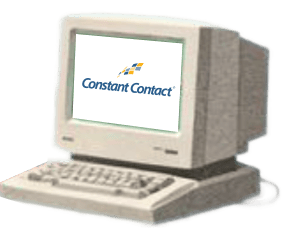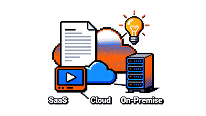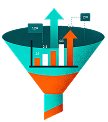The Future of GTM in the
Age of AI-Marketing
In our 3-part series, dubbed the Age of AI, we are exploring what is going to happen to Sales, Marketing and Customer Success teams over the next 2-5 years. If you haven’t seen our Sales series, check it out here.
Let's start with a look back at how marketing in technology has evolved over the last 25 years.
Welcome to Part 2
Marketing
2000s: The Era of Product-Led Awareness & SEO

This was the decade SaaS became mainstream (think Salesforce, NetSuite, Constant Contact).
Marketing was about explaining the “cloud” and building trust.


Evangelism & Education
Most buyers didn’t understand SaaS, so early marketing leaned heavily on whitepapers, webinars, and thought leadership explaining the value of cloud vs. on-premise.

Events & Trade Shows
In-person conferences (Dreamforce, SaaStr beginnings) were critical for early customer acquisition and brand legitimacy.

Email Marketing & Nurture Campaigns
Lists, gated content, and drip campaigns were the primary way to capture leads.

SEO & Content Blogging
Search was dominant. HubSpot, for example, pioneered inbound marketing by ranking for long-tail keywords and publishing how-to guides.

Free Trials / Freemium Introductions
Early SaaS players like Basecamp and Dropbox popularized "try before you buy" as a hook.
2010 - 2022: The Growth Hacking & Inbound Decade

Inbound Marketing at Scale
HubSpot, Marketo, and others made content-driven inbound + lead scoring a science.

Revenue Attribution
For the first time, marketing could directly tie campaigns to opportunities and closed-won deals, proving its impact on growth.

Account-Based Marketing (ABM)
Targeted plays for enterprise accounts gained traction, pioneered by Demandbase and Terminus.

Marketing as a Revenue Engine
Marketing shifted from being viewed as a service function to being recognized as a direct driver of pipeline and revenue.

Growth Hacking & Virality
Dropbox’s referral loop, Slack’s “invite your team” model, and LinkedIn’s network effects defined the era.

Social Media Marketing
LinkedIn, Twitter, and Facebook ads became mainstream for SaaS demand gen.

Sales Enablement
Marketing began building the content, collateral, and tools to help sales teams convert pipeline into revenue.

Marketing Automation & CRM Integration
Platforms like Marketo, Eloqua, and Pardot made nurture flows, scoring, and attribution standard.

Customer Success as Marketing
Metrics like CAC, LTV, and MQL→SQL→Closed Won became gospel.

Data-Driven Funnel Optimization
Retention and expansion got recognized as revenue-driving “marketing.”
As SaaS exploded, marketing became less about education and more about scaling fast and proving ROI.
Today: The Era of Community, PLG, and AI

Product-Led Growth (PLG) as Marketing
The product is the acquisition channel (e.g., Figma, Notion, Calendly).

Community-Led Growth
Building ecosystems around users (e.g., Notion templates, Webflow community, Slack groups).

Video & Short-Form Content
TikTok, YouTube Shorts, LinkedIn video posts drive awareness more than static blogs.

AI-Powered Personalization
Hyper-segmentation, dynamic copy, and predictive scoring.

Category Creation
Winning SaaS companies define their own category (e.g., Gong → “Revenue Intelligence”).

Full-Funnel Integration with Sales
ABM 2.0 blends marketing + sales + customer success with orchestration tools.
Today, buyers are savvy. Marketing has shifted to authenticity, ecosystems, and AI.
Tomorrow


Immersive/AR Experiences
Product demos in VR/AR, beyond static screenshares


Human Strategy
Keeping people at the center of every AI decision


Creative Story Telling
Blending data with emotion to move audiences


Partnerships - Developer community
Empowering developers as true brand advocates


AI Agent Management
Leading a new class of digital coworkers


Hyper-Personalization via Multimodal AI
Everything is customized to the end users taste and preferences


AEO/GEO
AI Engine Optimization - Human + AI Hybrid Storytelling – Where narrative authenticity matters as much as data


Decentralized Trust
Blockchain-based credentials, customer co-ownership of brands


AI Agents Driving Acquisition
Autonomous marketing campaigns that adapt in real-time. - Hyper-Personalization via Multimodal AI


AI Spokespeople
You will have agents out there managing user/buyer narrative, support, etc

From Channels to Systems: A New Mental Model
Historically, marketing has been structured around channels (SEO, paid, events, social). In the AI era, those silos collapse. AI platforms are already ingesting every customer touchpoint—email, calls, ads, support tickets—and synthesizing them into a single dynamic system.
Old question
How do we orchestrate adaptive campaigns that learn in real time?

New Questions
How do we train our AI engine to recognize intent signals earlier?
The Future is Systems
Intent Detection Systems
AI-Powered Buyer Signals
Unified Learning Loops
Intelligent Orchestration
Full-Funnel Feedback Systems
The Past Was Channels
SEO
SME
Paid Ads
Events
Social




Marketing Orgs Today
The Future of Marketing Orgs

Marketing Orgs Today
VP Marketing
The Future of Marketing Orgs

Technical VP Marketing
Architect of AI first systems, Architect for brand trust and most important strategic leader in AI first strategic growth.

Marketing Orgs Today
Product Marketing
The Future of Marketing Orgs

Technical Product Marketing
Develops simplified narratives between AI tool and market. Most importantly they will be the advocate and person who devleops trust between organizations and the AI.


Marketing Orgs Today
Demand Gen
SEO/SEM
The Future of Marketing Orgs

Demand Gen- AEO Specialist
Focuses on AI based campaigns targeting specific people or companies along with driving increased awareness across AI tools.

Marketing Orgs Today
Events Marketing Manager
The Future of Marketing Orgs

Technical Event Manager
We still think there will be a need for event focused team members but they won’t need agency support, will use AI agents to help create and run events.


Marketing Orgs Today
Content Marketing Manager
Designer
The Future of Marketing Orgs

Technical Content Manager- AI Storyteller
Translators who turn raw AI insights into human narratives for executives, boards, and customers—shaping strategic decisions through interpretation, not just dashboards.

Marketing Orgs Today
Revops
The Future of Marketing Orgs

GTM Engineer - Prompt Architects for Growth
Specialists who design, test, and refine AI prompts that drive personalized outreach, campaign copy, and ad variations at scale.

Marketing Orgs Today
Customer Marketing Manager
The Future of Marketing Orgs

GTM Engineer - Customer Signal Strategists
Experts in training AI systems to interpret micro-signals (scroll depth, dwell time, conversational tone) into actionable intent data.

Marketing Orgs Today
Partner/Channel Marketer
The Future of Marketing Orgs

Developer Relations
Similar to community relations but will focus on end user development through community, events, etc.
Entry-Level Marketing Roles
Even entry-level marketing positions are evolving in the Age of AI. While many traditional tasks will be automated, new roles will focus on AI-assisted execution, data interpretation, and creative problem-solving. Examples include:

AI Content Coordinator
Works with generative AI to draft copy, social posts, email campaigns, and blog content, ensuring tone, brand voice, and personalization

Data & Insights Analyst
Tracks AI-generated insights, interprets micro-signals from user behavior, and informs targeting strategies for demand generation and product marketing

Campaign Operations Specialist
Manages AI-driven campaigns, monitors performance metrics, and optimizes targeting using predictive insights

Event & Experience Coordinator
Supports hybrid and AI-assisted event execution, from virtual demos to immersive AR or VR experiences

Community & Engagement Associate
Supports online communities, forums, and user groups while leveraging AI tools to identify trends, surface opportunities, and grow engagement

Marketing Operations Apprentice
Learns the end-to-end AI-first marketing stack including CRM integration and automated reporting, building foundational skills for future strategic roles
Entry-level marketers will need a mix of creativity, technical fluency, and comfort collaborating with AI tools. These positions serve as the launching pad for tomorrow’s AI-savvy marketing leaders
The Structure of Tomorrow’s Marketing Teams
Campaigns
From
Conversations
To
Marketing shifts from one-to-many campaigns to ongoing, adaptive dialogues with each customer, powered by agentic AI.

Creativity
From
Co-Creation
To
The best campaigns won’t be “human-made” or “AI-made” but human-AI collaborations that expand the bounds of imagination.

Personas
From
Predictions
To
Static personas will die. AI systems will predict buyer needs dynamically, tailoring engagement at the individual level.

Measurement
From
Meaning
To
Vanity metrics will fade. AI will track outcomes at the level of customer lifetime systems—retention loops, advocacy signals, ecosystem value

Lean Core, Expansive Edge
The in-house team shrinks to a core of system designers, strategists, and storytellers. Executional roles are increasingly automated or outsourced to AI agents.
Embedded AI Pods
Instead of a central “marketing ops” team, each function will have AI copilots embedded —continuously learning, testing, and iterating.
Cross-Functional Fusion
Marketing, product, and sales blur into a single “growth system.” AI doesn’t respect departmental walls; it optimizes for the customer journey end-to-end.
Where Marketing Is Going
The Human Superpower in an AI-Driven Marketing World
“ Paradoxically, as AI takes over more executional work, the uniquely human skills—imagination, ethics, narrative intuition, and relationship-building—become more valuable than ever. The marketers who thrive won’t be those who fight automation, but those who direct it with clarity and creativity. “

Our thoughts
In the Age of AI, marketing is no longer about mastering tools or channels, it’s about designing adaptive systems, guiding intelligent agents, and telling stories only humans can tell. The winners will be the teams that reimagine marketing not as a function, but as an intelligent, living system embedded in the very fabric of the business.
The winners will be the teams that reimagine marketing not as a function, but as an intelligent, living system embedded in the very fabric of the business.

This would create far more opportunities for recent grads than they have today. Companies will need to treat this as a long term investment rather than a quick ROI. That can be a hard mindset shift for tech companies that move fast and expect immediate results.

Comp Engine
Comp Engine delivers fresh data every few minutes, keeping you ahead of the curve. Whether you're a hiring manager optimizing offer packages or a job seeker looking for fair market value, Comp Engine empowers you to make smarter, more competitive decisions to attract and retain top talent.

Recruitment as a Service
Betts' recruiter subscription model (RaaS) changes the future of recruiting with unlimited hires and full recruiter support. Betts connects the most extraordinary go-to-market talent with the most innovative companies in the world.
